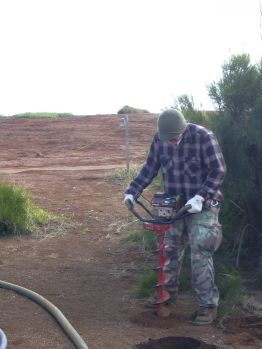Power-Auger Borings

|
| Operation of a Power Auger |
"Truck or trailer-mounted power augers are used for dry boring in unconsolidated materials. They range in size from Giddings rigs, which turn small diameter, solid stem flight augers to large rigs capable of turning 12-inch inside diameter, hollow stem augers. Test holes are advanced by rotating a cutting bit into the materials. A wide variety of materials may be bored with power augers. They are not suitable for use in materials containing cobbles or gravel, hard cemented soils, or saturated cohesionless soils. Unstable materials requiring casing, particularly below the water table."[1]
"Two different techniques of power-auger boring may be used to sample earth materials:
- screw the auger into the soil like a corkscrew, without mixing. The auger is then pulled from the hole and the materials are sampled and logged off the flights of the auger.
- Screw the auger into the soil like a corkscrew and the spin until the materials at the leading edge of the auger is brought to the surface. This is done when the power auger lacks the power to pull the auger from the soil after it is screwed in. The soil materials are logged and sampled as they are transported to the surface. Mixing of the materials is a problem, but with experience, good samples and interpretive information can be obtained."[1]
Examples
![]() National Engineering Handbook: Chapter 5 - Engineering Geology Logging, Sampling, and Testing
National Engineering Handbook: Chapter 5 - Engineering Geology Logging, Sampling, and Testing
Citations:
Revision ID: 4034
Revision Date: 10/24/2022
